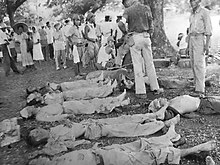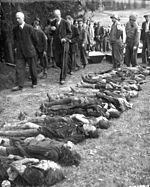Death march
A death march is a forced march of prisoners of war or other captives or deportees with the intent to kill, brutalize, weaken and/or demoralize as many of the captives as possible along the way.[citation needed] It is distinguished in this way from simple prisoner transport via foot march. Death marches usually feature harsh physical labor and abuse, neglect of prisoner injury and illness, deliberate starvation and dehydration, humiliation and torture, and execution of those unable to keep up the marching pace. The march may end at a prisoner-of-war camp or internment camp, or it may continue until all the prisoners are dead (a form of "execution by labor", as seen in the Armenian genocide among other examples).
The signing of the Fourth Geneva Convention[1] declared death marches a form of war crime.
Examples
Before World War II
- David Livingstone wrote of the East African slave trade:
We passed a slave woman shot or stabbed through the body and lying on the path. [Onlookers] said an Arab who passed early that morning had done it in anger at losing the price he had given for her, because she was unable to walk any longer.[2]
- As part of Indian removal in the United States, in 1831, approximately 6000 Choctaw were forced to leave Mississippi for Oklahoma, and only about 4000 arrived in 1832.[3]
- In 1836, after the Creek War, the United States Army deported 2,500 Muskogee from Alabama in chains as prisoners of war.[4] The rest of the tribe (12,000) followed, deported by the Army. Upon arrival in Oklahoma, 3,500 died of infection.[5]
- In 1838, the Cherokee nation were forced under Andrew Jackson to march westward towards Oklahoma. This march became known as the Trail of Tears: an estimated 4,000 men, women, and children died during relocation.[6]
- The Armenian Genocide resulted in the death of up to 1,500,000 people from 1915–1918. Under the cover of World War One, the Young Turks sought to cleanse Turkey of its Armenian population. As a result, much of the Armenian population was exiled from large parts of Western Armenia and forced to march to the Syrian Desert.[7] Many were raped, tortured, and killed on the way to the 25 concentration camps set up in the Syrian Desert. The most famous camp was that of Der Zor where an estimated 300,000 Armenians were killed.[8] The Turkish government denies these events.
During World War II
During WWII, death marches of POWs occurred in both Nazi-Occupied Europe and the Japanese Empire. Death marches of Jews were common in the later stages of the Holocaust as the Allies closed in on concentration camps in occupied Europe.


- During Operation Barbarossa, particularly during 1941–42 when large numbers of Soviet prisoners were captured, death marches were among the forms of German mistreatment of Soviet prisoners of war. Considered to be a German war crime.
- In the Pacific Theatre, the Imperial Japanese Army conducted death marches of Allied POWs, including the infamous Bataan Death March (1942) and Sandakan Death Marches (1945). The former forcibly transferred 60-80,000 POWs to Balanga, resulting in the deaths of 2,500–10,000 Filipinos and 100–650 Americans, the latter causing the deaths of 2,345 Australians and British, of which only 6 survived. Both the Bataan and Sandakan death marches were judged as war crimes.
- The term "death march" was used in the context of the World War II history by victims and then by historians to refer to the forcible movement between fall 1944 and April 1945 by Nazi Germany of thousands of prisoners, from Nazi concentration camps near the advancing war fronts to camps inside Germany. One infamous death march occurred in January 1945, as the Soviet Red Army advanced on occupied Poland. Nine days before the Soviets arrived at the death camp at Auschwitz, the SS marched nearly 60,000 prisoners out of the camp toward Wodzisław Śląski (German: Loslau), 35 miles away, where they were put on freight trains to other camps. Approximately 15,000 prisoners died on the way.[9][10] The death marches were judged as a crime against humanity.
After World War II
- During the Korean War, in the winter of 1951, 200,000 South Korean National Defense Corps soldiers were forcibly marched by their commanders, and 50,000 to 90,000 soldiers starved to death or died of disease during the march or in the training camps.[11] This incident is known as National Defense Corps Incident.
- During the 1948 Arab–Israeli War, some 70,000 Palestinian Arabs from the cities of Ramle and Lydda were forcibly expelled by Israeli forces. The event has come to be known as the Lydda death march.[12]
- During the Korean War, prisoners held by North Korea underwent what became known as the "Tiger Death March". The march occurred in the context of North Korea being over-run by United Nations forces. As North Korean forces had retreated to the Yalu River on the border with China, they had evacuated their prisoners with them. On 31 October 1950, some 845 prisoners, including about eighty noncombatants, left Manpo and went upriver, arriving on 8 November 1950 at Chunggang. A year later, fewer than 300 of the prisoners were still alive. The march was named after the brutal North Korean colonel who was in charge, nicknamed "The Tiger". Among the prisoners was George Blake, an MI6 officer who had been stationed in Seoul. While being held as a prisoner, he became a KGB double agent.[13]
- The 1975 forced evacuation of Phnom Penh in Cambodia under the Khmer Rouge
See also
- Carolean Death March (1718–1719)
- March of the Living
References
- ^ "Convention (IV) relative to the Protection of Civilian Persons in Time of War". International Committee of the Red Cross. Geneva: International Committee of the Red Cross. 12 August 1949. Retrieved 24 April 2014.
- ^ Livingstone, David (2006). The Last Journals of David Livingstone, in Central Africa, from 1865 to His Death. Echo Library. p. 46. ISBN 1-84637-555-X.
- ^ "Trail of Tears". Choctaw Nation.
- ^ Foreman, Grant (1974) [1932]. Indian Removal: The Emigration of the Five Civilized Tribes of Indians. University of Oklahoma Press. Archived from the original on April 13, 2012.
{{cite book}}: Unknown parameter|deadurl=ignored (|url-status=suggested) (help) - ^ "Creeks". Everyculture.com.
- ^ Marshall, Ian (1998). Story line: exploring the literature of the Appalachian Trail (Illustrated ed.). University of Virginia Press. ISBN 978-0-8139-1798-6.
- ^ "Exiled Armenians Starve in the Desert". The New York Times. Boston. August 8, 1916.
- ^ https://books.google.com/books?id=N1ARAAAAIAAJ&pg=PA42&lpg=PA42&dq=300,000+Armenians+Der+Zor&source=bl&ots=qu0ACupdzw&sig=TCV2pQqvfwo9Vl_uhRDUiZ5Jui8&hl=en&sa=X&ei=HJ8PVeWWCMvYggT1koLACw&ved=0CDoQ6AEwBQ#v=onepage&q=300%2C000%20Armenians%20Der%20Zor&f=false
- ^ "Death marches". United States Holocaust Memorial Museum.
- ^ Gilbert, Martin (May 1993). Atlas of the Holocaust (Revised and Updated ed.). William Morrow & Company. ISBN 0688123643. (map of forced marches)
- ^ Terence Roehrig (2001). Prosecution of Former Military Leaders in Newly Democratic Nations: The Cases of Argentina, Greece, and South Korea. McFarland & Company. p. 139. ISBN 978-0-7864-1091-0.
{{cite book}}: Cite has empty unknown parameter:|coauthors=(help) - ^ Holmes, Richard; Strachan, Hew; Bellamy, Chris; Bicheno, Hugh (2001). The Oxford companion to military history (Illustrated ed.). Oxford University Press. p. 64. ISBN 9780198662099.
On 12 July, the Arab inhabitants of the Lydda-Ramle area, amounting to some 70,000, were expelled in what became known as the 'Lydda Death March'.
- ^ Lewis H Carlson (2002). Remembered Prisoners of a Forgotten War: An Oral History of Korean War POWs. St Martin's Press. pp. 49–50, 60–62. ISBN 0-312-28684-8.
